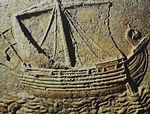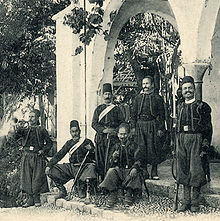- Mount Lebanon Mutasarrifate
-
History of Lebanon 
This article is part of a seriesAncient History Phoenicia Arab rule Ottoman rule French Rule Modern Lebanon 1958 Lebanon crisis Lebanese Civil War Cedar Revolution 2006 Lebanon War
Lebanon Portal
Mount Lebanon Mutasarrifate[citation needed] or Mutasarrifate of Mount Lebanon[1][2][3] (Arabic: متصرفية جبل لبنان Turkish: Cebel-i Lübnan Mutasarrıflığı) was one of the Ottoman Empire's subdivisions following the Tanzimat reform. After 1861 there existed an autonomous Mount Lebanon with a Christian mutasarrif, which had been created as a homeland for the Maronites under European diplomatic pressure following the 1860 massacres.
Contents
History
Historical background
Main article: 1840 Lebanon conflictAs the Ottoman Empire began to decline, the administrative structure came under pressure. Following continued animosity and fighting between the Maronites and the Druze, representatives of the European powers proposed to Sultan Abdülmecid I that the Lebanon be partitioned into Christian and Druze sections. The Sublime Porte was finally compelled to relinquish its plans for the direct rule of the Lebanon, and on December 7, 1842, the sultan adopted prince Metternich's proposal and asked Assad Pasha, the governor (wali) of Beirut, to divide the Mount Lebanon, into two districts: a northern district under a Christian Kaymakam and a southern district under a Druze Kaymakam, both chosen among tribal leaders. Both officials were to report to the governor of Sidon, who resided in Beirut.[4][5]
1860 conflict
On May 22, 1860, a small group of Maronites fired on a group of Druze at the entrance to Beirut, killing one and wounding two. This sparked a torrent of violence which swept through Lebanon. In a mere three days, from May 29 to 31, 1860, 60 villages were destroyed in the vicinity of Beirut.[4] 33 Christians and 48 Druzes were killed.[6] By June the disturbances had spread to the “mixed” neighborhoods of southern Lebanon and the Anti Lebanon, to Saida, Hasbaya, Rasheiya, Deir el Qamar and Zahlé. The Druze peasants laid siege to Catholic monasteries and missions, burnt them and killed the monks.[4] France intervened on behalf of the local Christian population and Britain on behalf of the Druze after the massacres, in which over 10,000 Christians were killed.[7][8]
Creation of the Mutasarrifiate
On September 5, 1860, an international commission composed of France, Britain, Austria, Prussia, Russia and the Ottoman Empire met to investigate the causes of the events of 1860 and to recommend a new administrative and judicial system for Lebanon that would prevent the recurrence of such events. The commission members agreed that the partition of Mount Lebanon in 1843 between Druze and Christians had been responsible for the massacre. Hence, in the Statute of 1861 Mount Lebanon was separated from Syria and reunited under a non-Lebanese Christian mutasarrif (governor) appointed by the Ottoman sultan, with the approval of the European powers. [4] The mutasarrif was to be assisted by an administrative council of twelve members from the various religious communities in Lebanon. Each of the six religious groups inhabiting the Lebanon (Maronites, Druzes, Sunni, Shi’a, Greek Orthodox and Greek Uniates) elected two members to the council.[4][8]
This Moutasarrifiat system lasted from 1861 till 1918.[9]
The mutasarrifs
Eight Moutasarrefs were appointed and ruled according to the basic Moutasarrifiat regulation that was issued in 1861 then modified by the 1864 reform. These were:
- Daoud Pacha 1861-1868
- Franko Pacha 1868-1873
- Rustom Pacha 1873-1883
- Wassa Pasha 1883-1892
- Naoum Pacha 1892-1902
- Mozafar Pacha 1902-1907
- Youssef Pacha 1907-1912
- Johannes Pasha 1912-1915
When the First World War broke out in 1914, Ahmed Djemal occupied Mount Lebanon militarily and revoked the Moutasarrifiat system. He appointed Moutasarrifs against the conformity of the basic regulation. Those governors were: Ali Mounif Beik, Ismail Beik and Moumtaz Beik[9]
See also
External links
References
- ^ Fisk, Robert ; Debevoise, Malcolm; Kassir, Samir (2010). Beirut. University of California Press. pp. 94. ISBN 9780520256682.
- ^ Salwa C. Nassar Foundation (1969). Cultural resources in Lebanon. Beirut: Librarie du Liban. pp. 74.
- ^ Winslow, Charles (1996). Lebanon: war and politics in a fragmented society. Routledge. pp. 291. ISBN 9780415144032.
- ^ a b c d e Lutsky, Vladimir Borisovich (1969). "Modern History of the Arab Countries". Progress Publishers. http://www.marxists.org/subject/arab-world/lutsky/ch09.htm. Retrieved 2009-11-12.
- ^ United States Library of Congress - Federal Research Division (2004). Lebanon A Country Study. Kessinger Publishing. pp. 264. ISBN 9781419129438.
- ^ Farah, Caesar E. The politics of interventionism in Ottoman Lebanon, 1830-1861, p. 564. I.B.Tauris, 2000. ISBN: 1860640567.
- ^ Fawaz, Leila Tarazi (1995). Occasion for War: Civil Conflict in Lebanon and Damascus in 1860 (illustrated ed.). I.B.Tauris & Company. pp. 320. ISBN 9781860640285.
- ^ a b U.S. Library of Congress. "Lebanon - Religious Conflicts". countrystudies.us. http://countrystudies.us/lebanon/18.htm. Retrieved 2009-11-23.
- ^ a b el-Mallah, Abdallah. "The system of Moutasarrifiat rule" (universitary). abdallahmallah.com. http://www.abdallahmallah.com/Moutasarrifia.html. Retrieved 2009-11-16.
Wikimedia Foundation. 2010.

